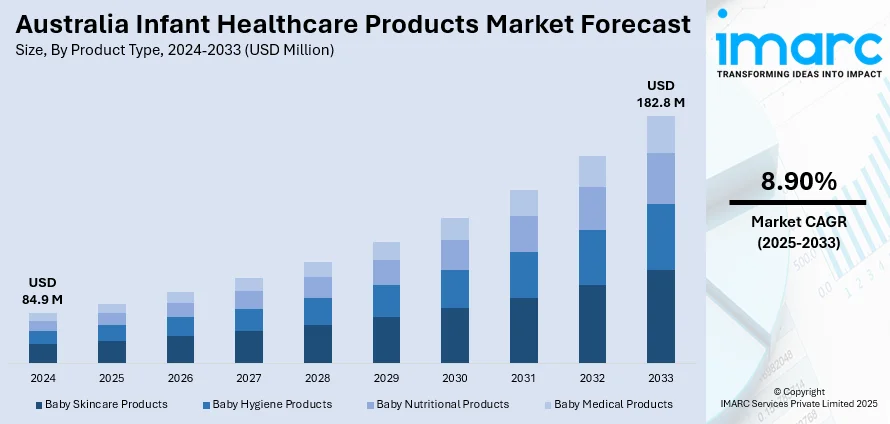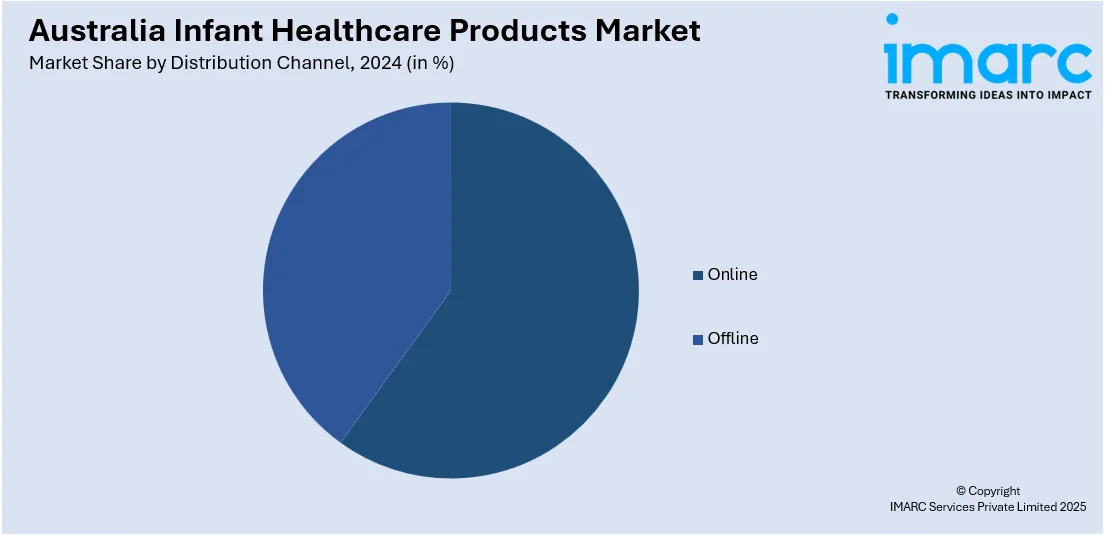
Australia Infant Healthcare Products Market Size, Share, Trends and Forecast by Product Type, Distribution Channel, Age Group, and Region, 2025-2033
Australia Infant Healthcare Products Market Size and Share:
The Australia infant healthcare products market size reached USD 84.9 Million in 2024. Looking forward, IMARC Group expects the market to reach USD 182.8 Million by 2033, exhibiting a growth rate (CAGR) of 8.90% during 2025-2033. The market is expanding significantly, driven by the rising demand for organic and natural products as consumers increasingly seek safer and environmentally friendly alternatives. In addition, the rapid growth of digital and omnichannel distribution channels has improved convenience and accessibility, making it easier for parents to purchase specialized healthcare items for their infants. A growing focus on preventive health and wellness for babies is also influencing consumer purchasing decisions. Together, these factors have fueled the market's dynamic growth and transformation. As a result, the Australia infant healthcare products market share is experiencing notable consolidation, as industry players respond strategically to evolving consumer preferences and market trends.
|
Report Attribute
|
Key Statistics
|
|---|---|
|
Base Year
|
2024
|
|
Forecast Years
|
2025-2033
|
|
Historical Years
|
2019-2024
|
|
Market Size in 2024
|
USD 84.9 Million |
|
Market Forecast in 2033
|
USD 182.8 Million |
| Market Growth Rate 2025-2033 | 8.90% |
Australia Infant Healthcare Products Market Trends:
Growing Demand for Natural and Organic Baby Healthcare Products
Australian parents are intensely concerned with the composition of infant healthcare products, leading to a discernible trend toward natural and organic products. Baby lotions, oils, wipes, and diaper creams are now required to be free from artificial fragrances, parabens, sulfates, and other synthetic chemicals. This is a result of heightened consciousness for skin sensitivity among infants and a wider lifestyle focus on living clean. Parents are also looking for cruelty-free and environmentally friendly packaging, further confirming their demand for sustainable consumption. Herbal and plant-based remedies are also increasingly in demand, especially in segments of baby skincare and hygiene. For instance, in April 2024, Else Nutrition introduced its soy-free, plant-based infant formula in Australia, for infants aged 6–36 months, capitalizing on the marketplace's high demand for clean-label, minimally processed infant healthcare products. Moreover, shoppers are becoming highly active in reading labels and knowing where products come from, and this stimulates manufacturers to put product transparency and clean-label innovation at the forefront. Australia infant healthcare products market growth has been increasingly powered by this natural and organic movement, particularly in urban areas where health and environmental consciousness are deeply ingrained within purchasing habits.

To get more information on this market, Request Sample
Growth of Digital and Omnichannel Distribution for Infant Healthcare
Digital transformation is reshaping the retail landscape in Australia, and infant healthcare products are no exception. Parents increasingly prefer the convenience of online shopping, which offers easy access to a wide range of baby skincare, hygiene, nutrition, and wellness products. E-commerce platforms provide detailed product comparisons, customer reviews, and subscription services, enhancing the overall shopping experience. Moreover, omnichannel strategies—where brick-and-mortar stores provide home delivery, online ordering, and in-store pick-up are further broadening access. For example, in December 2024, Marquise Baby introduced eco-friendly "On-the-Go" nappies, now available in 1000+ BP and 7-Eleven stores nationwide, offering parents high-quality, convenient, and sustainable baby care. Furthermore, this strategy is particularly useful for stressed-out parents and families in far-flung areas who might not be able to get their hands on specialty infant healthcare products immediately. Seasonal promotions and reward loyalty also encourage repeat purchases via digital touchpoints. Such a shift from conventional retail to digital-led approaches is influencing customer expectations, with availability and convenience emerging as top priorities. Australia infant healthcare products growth has been driven by the expanding role of digital commerce, mirroring evolving consumer behavior in both urban and rural markets.
Preventive Infant Health and Wellness Solutions Growth
Australian families increasingly are adopting preventive infant health practices, demonstrating an emerging trend toward wellness-conscious parenting. Parents currently invest consciously in products that promote immunity, nutrition, and early health, such as infant vitamins, probiotics, and supplements. The trend toward usage of medical devices like digital thermometers and nasal aspirators is also accelerating, with homes becoming highly independent in tracking infant health. Beyond nutrition and diagnostics, hygiene products such as alcohol-free sanitizers and non-toxic cleansers are becoming part of infant care rituals. This trend is underpinned by increasing access to educational resources focusing on early intervention, healthy lifestyles, and the significance of building a healthy immune foundation at birth. Parenting for health is becoming more prevalent, driving long-term demand for wellness-focused innovations. Australia infant healthcare products growth is partly being fueled by this preventive health approach, which indicates a more profound cultural interest in long-term health outcomes beginning from the earliest ages of life.
Australia Infant Healthcare Products Market Segmentation:
IMARC Group provides an analysis of the key trends in each segment of the market, along with forecasts at the country and regional levels for 2025-2033. Our report has categorized the market based on product type, distribution channel, and age group.
Product Type Insights:
- Baby Skincare Products
- Lotions
- Oils
- Creams
- Baby Hygiene Products
- Diapers
- Wipes
- Sanitizers
- Baby Nutritional Products
- Infant Formula
- Vitamins
- Supplements
- Baby Medical Products
- Thermometers
- Nasal Aspirators
The report has provided a detailed breakup and analysis of the market based on the product type. This includes baby skincare products (lotions, oils, creams), baby hygiene products (diapers, wipes, sanitizers), baby nutritional products (infant formula, vitamins, supplements), and baby medical products (thermometers, nasal aspirators).
Distribution Channel Insights:

- Online
- Offline
A detailed breakup and analysis of the market based on distribution channel have also been provided in the report. This includes online, and offline.
Age Group Insights:
- 0-6 Months
- 6-12 Months
- 1-3 Years
The report has provided a detailed breakup and analysis of the market based on the age group. This includes 0-6 months, 6-12 months, and 1-3 years.
Regional Insights:
- Australia Capital Territory & New South Wales
- Victoria & Tasmania
- Queensland
- Northern Territory & Southern Australia
- Western Australia
The report has also provided a comprehensive analysis of all the major regional markets, which include Australia Capital Territory & New South Wales, Victoria & Tasmania, Queensland, Northern Territory & Southern Australia, and Western Australia.
Competitive Landscape:
The market research report has also provided a comprehensive analysis of the competitive landscape. Competitive analysis such as market structure, key player positioning, top winning strategies, competitive dashboard, and company evaluation quadrant has been covered in the report. Also, detailed profiles of all major companies have been provided.
Australia Infant Healthcare Products Market News:
- In October 2024, Australia's Coco2, the globe's first coconut infant formula, is released in October 2024. With the University of Queensland, it was made for infants who are lactose intolerant and allergic. Experts advise parents see healthcare practitioners before changing formulas to have proper nutrition and infant health.
- In August 2024, Offspring Inc., a SEDANIA Group company, introduced the FeatherAIR Diaper for delicate baby skin. At only 1.5mm thin, it provides 11X absorption and 6X dryness with SapGuard core technology. The diaper is free from chlorine, dermatologist-tested, and has triple leakguard protection for maximum comfort and protection.
Australia Infant Healthcare Products Market Report Coverage:
| Report Features | Details |
|---|---|
| Base Year of the Analysis | 2024 |
| Historical Period | 2019-2024 |
| Forecast Period | 2025-2033 |
| Units | Million USD |
| Scope of the Report |
Exploration of Historical Trends and Market Outlook, Industry Catalysts and Challenges, Segment-Wise Historical and Future Market Assessment:
|
| Product Types Covered |
|
| Distribution Channels Covered | Online, Offline |
| Age Groups Covered | 0-6 Months, 6-12 Months, 1-3 Years |
| Regions Covered | Australia Capital Territory & New South Wales, Victoria & Tasmania, Queensland, Northern Territory & Southern Australia, Western Australia |
| Customization Scope | 10% Free Customization |
| Post-Sale Analyst Support | 10-12 Weeks |
| Delivery Format | PDF and Excel through Email (We can also provide the editable version of the report in PPT/Word format on special request) |
Key Questions Answered in This Report:
- How has the Australia infant healthcare products market performed so far and how will it perform in the coming years?
- What is the breakup of the Australia infant healthcare products market on the basis of product type?
- What is the breakup of the Australia infant healthcare products market on the basis of distribution channel?
- What is the breakup of the Australia infant healthcare products market on the basis of age group?
- What is the breakup of the Australia infant healthcare products market on the basis of region?
- What are the various stages in the value chain of the Australia infant healthcare products market?
- What are the key driving factors and challenges in the Australia infant healthcare products?
- What is the structure of the Australia infant healthcare products market and who are the key players?
- What is the degree of competition in the Australia infant healthcare products market?
Key Benefits for Stakeholders:
- IMARC’s industry report offers a comprehensive quantitative analysis of various market segments, historical and current market trends, market forecasts, and dynamics of the Australia infant healthcare products market from 2019-2033.
- The research report provides the latest information on the market drivers, challenges, and opportunities in the Australia infant healthcare products market.
- Porter's five forces analysis assist stakeholders in assessing the impact of new entrants, competitive rivalry, supplier power, buyer power, and the threat of substitution. It helps stakeholders to analyze the level of competition within the Australia infant healthcare products industry and its attractiveness.
- Competitive landscape allows stakeholders to understand their competitive environment and provides an insight into the current positions of key players in the market.
Need more help?
- Speak to our experienced analysts for insights on the current market scenarios.
- Include additional segments and countries to customize the report as per your requirement.
- Gain an unparalleled competitive advantage in your domain by understanding how to utilize the report and positively impacting your operations and revenue.
- For further assistance, please connect with our analysts.
 Request Customization
Request Customization
 Speak to an Analyst
Speak to an Analyst
 Request Brochure
Request Brochure
 Inquire Before Buying
Inquire Before Buying




.webp)




.webp)












